The US dollar pulled back against all the other major currencies yesterday and today in Asia, with most equity indices trading in the green. However, with no clear catalyst behind the improvement in market sentiment, and no apparent change in the fundamental landscape, we believe that this may have been due to portfolio rebalancing on the last day of a very turbulent month.
The USD Pulls Back and Risk Assets Rebound, but No Change in Fundamentals
The US dollar traded lower against all the other major currencies on Monday and during the Asian session Tuesday. It lost the most ground versus AUD, EUR, and CHF in that order, while it underperformed the least versus GBP.
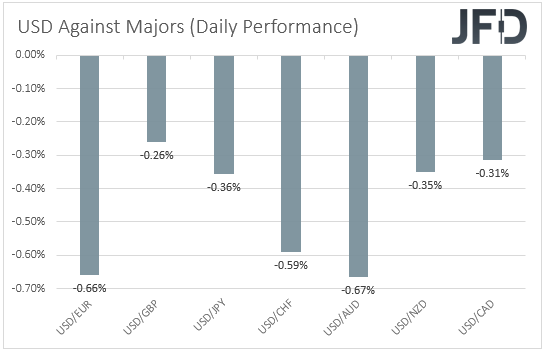
The weakening of the US dollar, combined with the strengthening of the Aussie, suggests a risk-on trading activity, but the strengthening of the Swiss franc points otherwise. Thus, to get a clearer picture regarding the broader market sentiment, we prefer to turn our gaze to the equity world.
We see that most European shares traded in the green, with optimism increasing during the US session. Today, in Asia, only Japan’s Nikkei was open, and it finished up as well.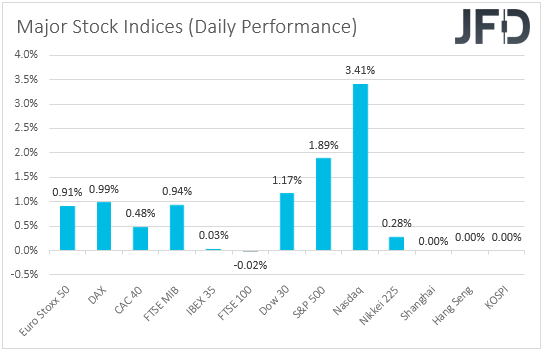
In our view, the fundamental landscape has barely changed. Still, market participants anticipate a 25 bps hike by the Fed in March and multiple more until the end of the year. Specifically, according to the Fed funds futures, investors are fully pricing in a total of nearly five quarter-point liftoffs by December.
On top of that, the uncertainty surrounding Eastern Europe remains elevated, with the UK warning it is “highly likely” that Russia is looking to invade Ukraine.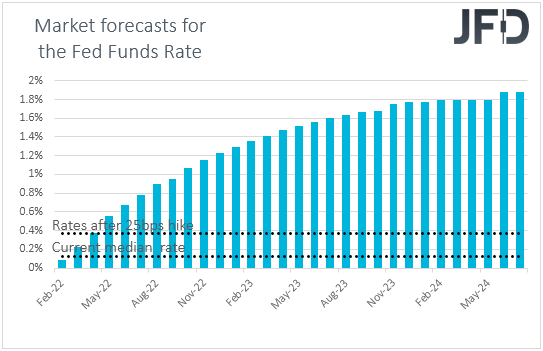
So, with all that in mind, we believe that yesterday’s rebound in equities may have been the result of some portfolio rebalancing after an abysmal start of the year. Specifically, NASDAQ avoided its worst-ever January narrowly, while the S&P 500 recorded its weakest January since 2009.
Even if equities continue to recover, as some investors may have already digested the idea of faster rate hikes, we prefer to adopt a cautious stance and take things step by step. At the moment, we prefer to trust some more recovery in European indices, and this is because we see the case for the ECB to lift interest rates much slower than the Fed. We still believe that Eurozone policymakers will avoid pressing the hike button this year.
Now, back to the currencies, the Aussie was the best performing major currency, and if it wasn’t for the RBA, it could have gained more. The Bank decided on monetary policy during the Asian session today, keeping interest rates untouched at 0.10% and announcing the end of its QE purchases, as was broadly expected.
However, in the statement accompanying the decision, it was noted that, while inflation has picked up, it is too early to conclude that it is sustainably within that target band and that they will not increase the cash rate until that happens.
The Aussie fell nearly 40 pips against its US counterpart at the time of the release, perhaps as the outcome was a clear message that the RBA is not willing to proceed with as many rate hikes as the current market pricing suggests.
However, the currency was quick to bounce back and cover the RBA-related losses, perhaps aided by the broader risk recovery or because most participants kept bets around the RBA’s rate path elevated. According to the ASX 30-day interbank cash rate futures yield curve, investors continue to see the OCR above 1.0% by the end of this year.
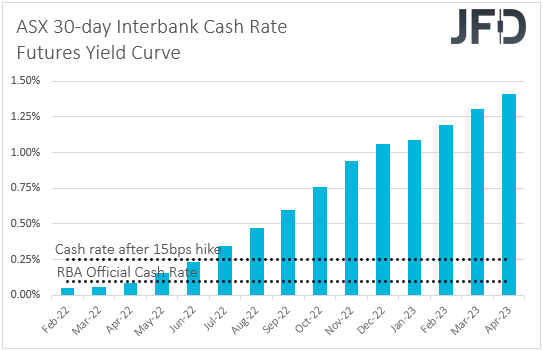
EURO STOXX 50 – Technical Outlook
The Euro Stoxx 50 cash index traded higher on Monday, extending the recovery started on Jan. 24, after the index hit support near the crossroads of the upside support line drawn from the low of May 13 and the 4030 barrier. As long as the index stays above that line, we would see decent chances for more advances in the short run.
A clear break above the 4231 barrier, marked by the inside swing lows of January 18th and 19th, could confirm the case and may initially target the 4303 zone, marked by the peak of Jan. 20. If market participants are not willing to stop there, we could see them climbing towards the peak of Jan. 18, at 4415. Another break, above 4415, will take the index into territories last seen in December 2007, with the next resistance perhaps being the peak of that month, at around 4500.40.
Now, to abandon the bullish case, we would like to see an apparent dip below 4030, a territory that provided strong support between Nov. 30 and Jan. 24. This could also confirm the break below the aforementioned upside line and may initially pave the way towards the low of Jul. 19, at 3900. Another beak, below 3900, could extend the fall towards the 3800 zone, or the 3740 territory, marked by the inside swing high of Mar. 3.
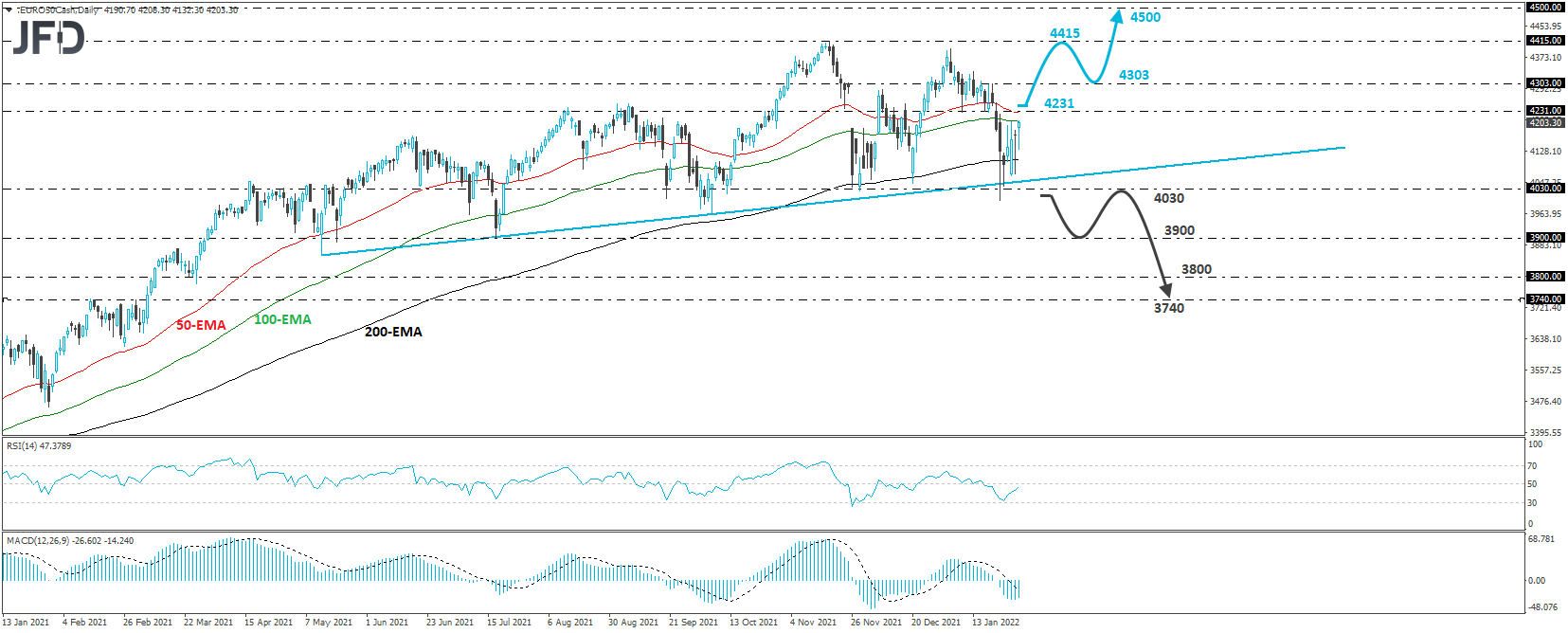
AUD/JPY – Technical Outlook
AUD/JPY traded lower after the RBA outcome but quickly rebounded to recover those losses. However, the rate remains below the downside line taken from the high of Jan. 5, and thus, we believe that any further advances could stay short-lived. We see decent chances for another leg south soon.
An apparent dip below 80.70, marked by the low of Jan. 24, could confirm the notion and see scope for declines towards the low of Dec. 20, at 80.25, or the low of Dec. 7, at 79.85. If the bears are strong enough to overcome that barrier as well, then we may see them driving towards the 79.05 barrier, marked by the low of Dec. 6.
The outlook might change to positive upon a break above 82.05. This could confirm the break above the aforementioned downside line and trigger advances towards the 83.00 zone, which provided resistance on Jan. 18 and 20. If the bulls are unwilling to stop there, we could see them climbing towards the 83.36 level, or the 83.75 zone, with the latter being marked by the high of Jan. 13.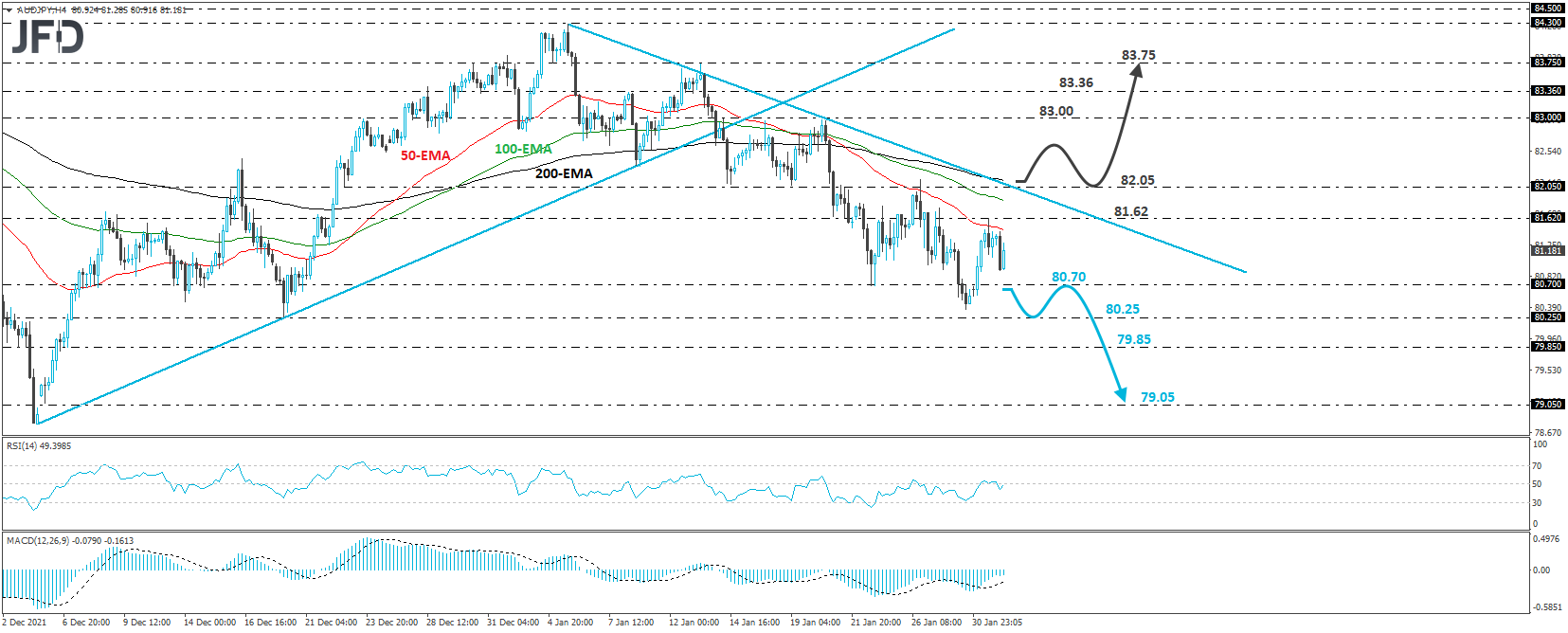
Today’s Events
Today, we get the final manufacturing PMIs for January from the Eurozone, the UK (already out), and the US, but as is usually the case, they are expected to confirm their preliminary estimates.
The US ISM manufacturing index for the month is also coming out and expectations are for a slide to 57.5 from 58.7. In Canada, the monthly GDP for November is expected to reveal a slowdown to +0.4% MoM from +0.8%.
Tonight, during the early Asian morning Wednesday, New Zealand’s unemployment rate for Q4 is expected to have stayed unchanged, with the employment change expected to have slowed to +0.3% QoQ from +2.0%. That said, the Labor Costs Index is expected to have accelerated to +2.9% YoY from +2.5%, keeping the door open for more rate hikes by the RBNZ.
